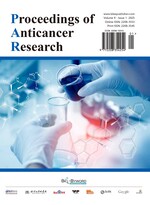The High Expression of EXOSC3 in OSCC is Associated with Poor Prognosis and Immune Infiltration
Abstract
Oral squamous cell carcinoma (OSCC) is the most common malignant tumor in the oral and maxillofacial region, primarily affecting the tongue, gingiva, oral cavity, buccal mucosa, and floor of the mouth. It exhibits high rates of recurrence and metastasis, contributing to a poor prognosis for patients. Identifying molecular markers associated with OSCC holds significant value for advancing its diagnosis, treatment, and prognosis. Exosome Component 3 (EXOSC3) is a protein-coding gene involved in the auto-degradation of E3 ubiquitin ligase COP 1 and rRNA processing in the nucleus and cytoplasmic sol. This gene plays a crucial role in diseases such as colon cancer and non-small cell lung cancer. Bioinformatics analysis revealed that EXOSC3 expression is significantly elevated in OSCC and is associated with poor patient prognosis. Gene Ontology (GO) and Kyoto Encyclopedia of Genes and Genomes (KEGG) enrichment analyses indicate that EXOSC3 is strongly linked to the cytokine-cytokine receptor interaction, Toll-like receptor signaling pathway, and JAK-STAT signaling pathway. Moreover, immune infiltration analysis demonstrated a significant association between EXOSC3 expression and immune cell subset infiltration, as well as immune checkpoint expression, underscoring its importance in OSCC. However, further research is required to elucidate the specific role of EXOSC3 in OSCC diagnosis and treatment. A comprehensive investigation into the mechanisms of EXOSC3 in OSCC may reveal new potential targets for improving the diagnosis and treatment of this malignancy.
口腔鳞状细胞癌(Oral squamous cell carcinoma,OSCC)是口腔颌面部最常见的恶性肿瘤,主要发生在舌、牙龈、口腔、颊粘膜和口底等部位。它具有高度复发性和转移性,导致患者预后不良。因此,寻找与口腔鳞状细胞癌相关的分子标志物对口腔鳞状细胞癌的诊断、治疗和预后具有重要意义。Exosome Component 3是一种蛋白质编码基因,与E3泛素连接酶COP 1的自身降解以及rRNA在细胞核和细胞质溶胶中的加工有关,在结肠癌和非小细胞肺癌中发挥重要作用。通过生物信息学,我们发现EXOSC 3在OSCC中的表达显著增加,并且与患者预后不良相关。GO和KEGG富集分析显示EXOSC 3与细胞因子-细胞因子受体相互作用、Toll样受体信号通路和JAK-STAT信号通路显著相关。此外,免疫浸润分析显示,EXOSC 3与免疫细胞亚群的浸润和免疫检查点的表达显著相关,突出了EXOSC 3在OSCC中的重要性。然而,需要进一步的研究来确定EXOSC 3对口腔鳞癌诊断和治疗的具体影响。这将有助于我们全面了解EXOSC 3在OSCC中的作用机制,为OSCC的诊断和治疗提供新的潜在靶点。
References
Bugshan A, Farooq I, 2020, Oral Squamous Cell Carcinoma: Metastasis, Potentially Associated Malignant Disorders, Etiology and Recent Advancements in Diagnosis. F1000Res, 9: 229. https://doi.org/10.12688/f1000research.22941.1
Chai A, Lim KP, Cheong SC, 2020, Translational Genomics and Recent Advances in Oral Squamous Cell Carcinoma. Semin Cancer Biol, 61: 71–83. https://doi.org/10.1016/j.semcancer.2019.09.011
Ma X, Yang R, Li H, et al., 2024, Role of Exosomes in the Communication and Treatment Between OSCC and Normal Cells. Heliyon, 10(7): e28148. https://doi.org/10.1016/j.heliyon.2024.e28148
Ramqvist T, Dalianis T, 2011, An Epidemic of Oropharyngeal Squamous Cell Carcinoma (OSCC) Due to Human Papillomavirus (HPV) Infection and Aspects of Treatment and Prevention. Anticancer Res, 31(5): 1515–1519.
Eggens VR, Barth PG, Niermeijer JM, et al., 2014, EXOSC3 Mutations in Pontocerebellar Hypoplasia Type 1: Novel Mutations and Genotype-Phenotype Correlations. Orphanet J Rare Dis, 9: 23. https://doi.org/10.1186/1750-1172-9-23
Lu G, Liu H, Wang H, et al., 2024, Potentially Functional Variants of INPP5D and EXOSC3 in Immunity B Cell-Related Genes are Associated with Non-Small Cell Lung Cancer Survival. Front Immunol, 15: 1440454. https://doi.org/10.3389/fimmu.2024.1440454
Tomczak K, Czerwinska P, Wiznerowicz M, 2015, The Cancer Genome Atlas (TCGA): An Immeasurable Source of Knowledge. Contemp Oncol (Pozn), 19(1A): A68–A77. https://doi.org/10.5114/wo.2014.47136
Ritchie ME, Phipson B, Wu D, et al., 2015, Limma Powers Differential Expression Analyses for RNA-Sequencing and Microarray Studies. Nucleic Acids Res, 43(7): e47. https://doi.org/10.1093/nar/gkv007
Xu S, Hu E, Cai Y, et al., 2024, Using clusterProfiler to Characterize Multiomics Data. Nat Protoc, 19(11): 3292–3320. https://doi.org/10.1038/s41596-024-01020-z
Chen B, Khodadoust MS, Liu CL, et al., 2018, Profiling Tumor Infiltrating Immune Cells with CIBERSORT. Methods Mol Biol, 1711: 243–259. https://doi.org/10.1007/978-1-4939-7493-1_12
Oyeyemi BF, Kaur US, Paramraj A, et al., 2023, Microbiome Analysis of Saliva from Oral Squamous Cell Carcinoma (OSCC) Patients and Tobacco Abusers with Potential Biomarkers for Oral Cancer Screening. Heliyon, 9(11): e21773. https://doi.org/10.1016/j.heliyon.2023.e21773
Liu B, Si W, Wei B, et al., 2023, PTP4A1 Promotes Oral Squamous Cell Carcinoma (OSCC) Metastasis Through Altered Mitochondrial Metabolic Reprogramming. Cell Death Discov, 9(1): 360. https://doi.org/10.1038/s41420-023-01657-x
Mumtaz M, Bijnsdorp IV, Bottger F, et al., 2022, Secreted Protein Markers in Oral Squamous Cell Carcinoma (OSCC). Clin Proteomics, 19(1): 4. https://doi.org/10.1186/s12014-022-09341-5
Szeto CH, Rubin S, Sidlow R, 2023, Homozygous EXOSC3 c.395A>C Variants in Pontocerebellar Hypoplasia Type 1B: A Sibling Pair with Childhood Lethal Presentation and Literature Review. Cureus, 15(5): e39226. https://doi.org/10.7759/cureus.39226
Bauer L, Hapfelmeier A, Blank S, et al., 2018, A Novel Pretherapeutic Gene Expression-Based Risk Score for Treatment Guidance in Gastric Cancer. Ann Oncol, 29(1): 127–132. https://doi.org/10.1093/annonc/mdx685
Xie Y, Wu H, Hu W, et al., 2022, Identification of Hub Genes of Lung Adenocarcinoma Based on Weighted Gene Co-Expression Network in Chinese Population. Pathol Oncol Res, 28: 1610455. https://doi.org/10.3389/pore.2022.1610455
Fu Q, Yang F, Liao M, et al., 2019, Rap GTPase Interactor: A Potential Marker for Cancer Prognosis Following Kidney Transplantation. Front Oncol, 9: 737. https://doi.org/10.3389/fonc.2019.00737
Xu Y, Yao Y, Yu L, et al., 2023, Clathrin Light Chain A Facilitates Small Extracellular Vesicle Uptake to Promote Hepatocellular Carcinoma Progression. Hepatol Int, 17(6): 1490–1499. https://doi.org/10.1007/s12072-023-10562-5
Di Lorenzo A, Bolli E, Tarone L, et al., 2020, Toll-Like Receptor 2 at the Crossroad Between Cancer Cells, the Immune System, and the Microbiota. Int J Mol Sci, 21(24): 9418. https://doi.org/10.3390/ijms21249418
Shao F, Pang X, Baeg GH, 2021, Targeting the JAK/STAT Signaling Pathway for Breast Cancer. Curr Med Chem, 28(25): 5137–5151. https://doi.org/10.2174/0929867328666201207202012

